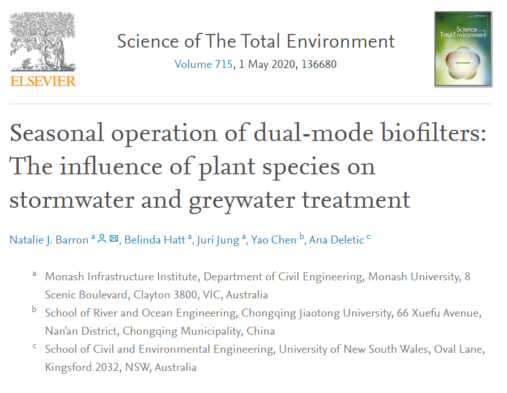Seasonal operation of dual-mode biofilters: The influence of plant species on stormwater and greywater treatment
Abstract
The use of stormwater biofilters (also known as bioretention systems and raingardens), in tropical and semi-arid areas is hindered by seasonal rainfall patterns which cause extended dry periods. These periods can result in plant die-off, long-term damage to system health and leaching of pollutants when stormwater inflows resume. Using an additional polluted water source during dry periods could minimise system stress and eliminate the need to irrigate biofilters with potable water during dry spells. As such, the presented laboratory study tested the seasonal operation of biofilters, by switching from stormwater treatment in wet months to greywater treatment in dry months. Forty-five single planted biofilter columns, incorporating sedges, grasses, understory ornamentals and vines, were subjected to four months of stormwater inflows, followed by three months of greywater inflows. We also investigated the impact of including a carbon source in the saturated zone on treatment performance. The results showed plant species selection to be critical for nitrogen and phosphorus removal, with consistently effective species such as Carex appressa and Canna x generalis able to maintain low outflow concentrations (e.g. total nitrogen of 0.2–0.3 mg/L and 0.3–0.6 mg/L, respectively) across both water sources. Low outflow phosphorus concentrations were associated with plant species that had high filterable reactive phosphorus removal across both water sources. Similarly, higher removal of ammonia and oxidised nitrogen was associated with lower overall nitrogen concentrations. In contrast, high removal of total suspended sediment (>94%), biochemical oxygen demand (>98%) and some heavy metals (e.g. lead >98% and copper >93%) was reported across all designs. The results suggest that with the careful selection of plant species, biofilters can be operated seasonally as a feasible and practical solution to maintaining system health during extended dry periods.
